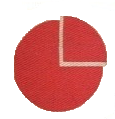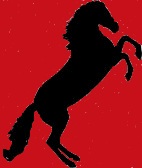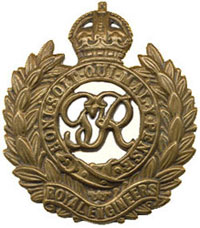The Shiny Seven in the Italian Campaign - The Gustav Line March - April 1944
Company TRF
4 Division TRF
Napoleon said, " Italy is like a boot. You have to enter it from the top".
There are many books on the battles of Monte Cassino. The picture above left is the cover of Matthew Parker's book that has many excellent reviews. There is a chapter on the Amazon bridge where 7 Field Company RE features a lot and also in a previous chapter. The book covers all the facts mainly from many personal accounts.
ISBN 978-0-7553-1176-7
Excerpt from Matthew Parker's Book
The six-month battle for Monte Cassino was Britain's bitterest and bloodiest encounter with the German army on any front in World War Two.
At the beginning of 1944 Italy was the western Allies' only active front against Nazi-controlled Europe, and their only route to the capital was through the Liri valley. Towering over the entrance to the valley was the medieval monastery of Monte Cassino, a seemingly impenetrable fortress high up in the 'bleak and sinister' mountains. This was where the German commander, Kesselring, made his stand.
MONTE CASSINO tells the extraordinary story of ordinary soldiers tested to the limits under conditions reminiscent of the bloodbaths of World War One. In a battle that became increasingly political, symbolic and personal as it progressed, more and more men were asked to throw themselves at the virtually impregnable German defences. It is a story of incompetence, hubris and politics redeemed at dreadful cost by the heroism of the soldiers.
16 March. HMT Devonshire docked in the battered docks of Naples at 0900hrs and the 7th disembarked quickly and the Platoons formed up to wait for transport to take them to Castrese south of a bridgehead over the River Garigliano. Once transport arrived no time was wasted reaching the location and within minutes of arriving vehicles were emptied.
Billets were empty one storey houses with earth floors. A battery of guns close by introduced themselves with frequent stonks, and the enemy overlooking the valley was not slow to reply. By 1800hrs as darkness was falling the 7th were eating and taking in their new surroundings.
17 March. A day of checking, cleaning and preparing for a move by Platoons into the bridgehead.
18 March. At 0730hrs. 3 Platoon led by the OC moved off on foot along Sun Track to the flat valley floor to cross ‘Skipton’ bridge a FBE bridge capable of taking light vehicles. Sun Track was in full view of enemy observers, who brought down regular stonks. 2 Platoon left an hour later. The Platoons moved in single file well spaced out, dressed in marching order with two

Following their victories in North Africa the Allies invaded Sicily then the Italian mainland, landing at Reggio on the Toe of Italy, Taranto and Salerno.
The retreating Germans from Sicily withdrew onto the Italian mainland and immediately worked on a series of defensive lines up the leg of Italy as shown on the map right. Prior to the Allies reaching these lines, the Germans employed skilful delaying tactics playing for time for their construction. The Apennine mountains ran up the centre of Italy with Spurs, re-entrants, rivers and ravines running from it, making it ideal for defenders. The Allies captured a mountain, only to be confronted with another. The Sappers were very busy in the Italian Campaign helping keep the battles moving, clearing mines, repairing roads and building Bailey bridges, 2,800 of them were built in the Italian Campaign. General Alexander said "without the Bailey bridge the Italian Campaign would have been doomed from the outset".

21 March 1944. Sappers Groves & Carol were slightly wounded by an 'S'mine in the Orange Groves
22 March 1944. Sapper Close was seriously wounded (lost a leg) by a “Schu” mine while helping the 2/4 Hants clearing mines in the Orange groves.
19 April. The Company concentrated on training with Bailey Bridge and FBE, the equipment was handled so much it was an automatic reflex to use any part of it.
23 April Sunday. Company HQ was set up at Mignano and Shiny 7 spent the next few days on intensive bridging, whilst Major Low and Lt Roberts led small parties on recces of the ‘Rapido’ to select a site for ‘Congo’. Major Low made several attempts to cross with a line until finally Sgt F Clark a very powerful swimmer swam across with the line to measure the gap, and recce the far bank. At this time the enemy had positions on both sides of the river, usually the patrols melted into the darkness and were very silent moving about and therefore as a precaution some sappers left their identity discs outside their uniform to indicate that they were British troops.
26 April Wednesday. The main body of the 7th moved to Mignano, in pouring rain, camp was set up and though the location was within shell range no shells fell on it. The location lay on the north side of Route 6 where the railway ran on the opposite side of route 6. Recces were completed for the clearance of mined areas to be used by 28 Bde. Tracks, roads and ‘Speedway Express’ were noted as tasks for the period of preparation. Mines to be cleared were A/T Tellermines and the ‘Holz’, a wooden mine, A/P mine ‘Schu’, the detectors could not pick up the wooden mines. It was necessary to use either bayonets or prodders manufactured by 18 Fd Coy. Very few people had seen wooden mines before arriving in Italy. The 7th were lucky to have so much minefield experience. To give some idea of the extent of mining in the Cassino area, after capturing Cassino 500,000 mines were lifted in the town area alone by the Cassino task force.
31 March. 1 Pl and eighteen Pioneers of the ILA, an Italian detachment, who were permanently attached, established a water point at Aquafondata.
01 April. ‘B’ Echelon headed for 18 Fd Pk Coy RE at Vitecuso, ‘A’ Echelon moved to Aquafondata, then four miles north, within striking distance of Cassino attracting a stonk by the 5th German Mountain DIV, the immediate enemy in the area. The OC and the Recce officers recced the new area, tracks, roads, crater points, materials etc. This area north of Cassino was won by the French and Americans, and it included a bridgehead across the river Rapido into the lower mountains guarding Cassino from the north. The positions were in full view of the enemy who held the formidable 5000’ high Mt Cairo, and a number of other mountains over 3000’ all of which dominated the area. During daytime there was no sign of life but then as dusk turned to darkness and until the morning mist cleared the next day, the whole area became a hive of activity. The Germans brought down the odd heavy stonk with shrapnel cascading down the mountain sides with hot metal showing up like big sparks from a fire. Over the next two weeks the Shiny 7 HQ was located off the North road near Vallerotonda. Platoons rotated between ‘Inferno’, and an assault bridge camp run by Canadian Sappers at Vairano.
15 April. HQ ‘A’ Echelon moved to Pietravairano. 2 Pl HQ and 5 Section were at Caira and the remainder of the Platoon worked at night on roads in the valley beyond St Elia under command of 14 Fd Coy Canadian RE.

Above: Wooden German (holtz) 'Schu' Mine
The terrain of Italy made the military deployment of animals necessary. Procurement of horses and mules were made locally but soon extended to Sardinia, Corsica, French North Africa and British Near East. Many thousands were used by the Allies in 1943-45
7 Field Company RE were first billeted at Castrese and in the hill top village of Lauro, which at one time had been occupied by the Germans. Many of the buildings were badly damaged through earlier fighting.
The billets were mainly houses around the village square
The above map shows that there are five mountain tops over 2000ft in this massif: Cerasola, Ornito, Tuga, Turlito and Rotondo. The tops were "no mans land", the Germans held the northern slopes and our troops held the southern sides, each side periodically shelling and mortaring the other from very precariously held positions. It was a classic holding operation. Re-supply to our forward troops was by mule at night using mule tracks, which were all named. The Germans could not always see the tracks but they knew where they were and would shell them from time to time. New tracks were sometimes made to replace those receiving too much enemy attention
A Vetinary officer inspects the leg
of a Mule
The Company joins the Italian Campaign and heads for the hills, clearing mines, water supply, maintaining, repairing, improving supply tracks and roads to the front line, bridging training 16 March-30 April 1944
Photo: Paul Hooton
Skipton Bridge February 1944
Rations were good, and the ten-man ration packs were convenient for mule and porter transport from Skipton to Harrogate-Cheshire dumps. The packs included tinned bacon, steak and kidney pudding, treacle roll, tea, biscuits, chocolate, sweets, cheese, jam, margarine, cigarettes and toilet paper. These were supplemented by cakes baked at “B” Echelon. To make up for the lack of fresh fruit and vegetables, many of the Jeep Head parties with the help of the sappers, swept lanes in the orange groves to gather oranges for the men up in the hills on the front line. Some parties collected as many as a thousand oranges in one day.


blankets. 3 Platoon passed ‘Skipton Dump’, winding their way up the mountain to a base at ‘Harrogate’ Valle di Suio. Coy Tac HQ was established and billets were broken ‘casas’. The method of supply was by Jeep Train to ‘Skipton dump’, where mules were driven by Italian troopers. The mules hauled the loads to ‘Cheshire’ dump near the limit of the bridgehead where Brigade HQ was established. Porters, ‘Basuto Boys’ took the loads further up. The forward infantry units provided porters to distribute supplies to the most advanced positions. From ‘Cheshire’ near Mt Tuga 2188’ high, all troops lived in sangars, these were walls of rock built into defence positions. They were lined with a ground sheet or bivvy or anything suitable to cover against the elements. During the day movement was out of the question and water was rationed to 2 pints, supplemented by melted snow. Some positions had screens in front to prevent grenades being tossed into them. After crossing ‘Skipton bridge’ 2 Platoon turned left on a metal road at the base of the mountains using a two storey ‘casa’ as a billet and HQ. Their task was similar to 3 Pl, construction and maintenance of ‘Jeep’ tracks and in addition the clearance of an A/P minefield laid in orange groves between the road and the river. The area was infested with ‘S’ mines dug in below ground level. The enemy had laid some nasty surprises near buildings in the shape of A/T mines buried out of reach of the detectors. One blew up outside a building being used as a casualty station on the flat near the road.

Pateley bridge was a FBE bridge and was restricted to 9 ton loads. It was in view of the enemy, who tendered to shell it whenever anyone was crossing it. The technique for crossing was not to follow another vehicle but to wait and dash across independently. The Germans usually fired when they saw a vehicle crossing, too late to hit the vehicle, but might catch a following vehicle or create a pot hole in the road in front of it.
During this period the platoons were rotating between, Acquafondata, North Road, Inferno Track, Hove dump, Rapido Valley, Caira and bridge camps
The Monte Camino massif was on the 'Bernhard' Line, which was a delaying line for the Gustav line. It was finally taken in December 1943 before the arrival of the Shiny 7. However, this illustrates the very difficult terrain the Allies were confronted with all the way up the leg of Italy, and is the background to the situation the Shiny 7 would soon experience.


Resupplying the Belvedere Front Line opposite Terelle, February - May 1944
The route to resupply the front line north of Cassino was via Pozzili - Casala - Viticuso - Acquafondata - Hove Dump near Portella - Terelle road Jeephead above Caira. The route up to Acquafondata was known as “Shap”. It was two way traffic and headlights were permitted to be used as far as Acquafondata. There was an intermediate stores dump at Aqcquafondata known as Brighton Dump. From Acquafondata the route was known as the North road and went all the way to Sant Elia Fiumerapido and Hove Dump. Traffic down the North road was strictly controlled and authority had to be obtained in advance. As it was in view of the enemy, traffic was only permitted during the hours of darkness. The only exception to this was ambulance cars, flagged jeeps and motor cycles at 5 minute intervals. From dusk to midnight the flow of traffic was east to west only. Midnight to first light west to east. Vehicles were restricted to 120 vehicles each way. No lights of any sort were allowed on the North road. It was essential that traffic was clear of the North road by daylight. Any vehicle breakdowns that could not be recovered quickly and was holding up traffic that was in danger of observed shell fire at daylight, was to be abandoned and pushed clear over the edge. Trucks were unloaded at Hove Dump, from thereon Jeeps would leave each evening loaded to the brim, race across the valley to Caira and drive up Terelle road to the Jeephead. Unit reps would meet and unload the jeeps quickly and quietly and carry everything by foot or by mule to their positions.
Acquafondata - Rapido Valley - Caira 30 March - 19 April 1944
Hove Dump was in a gulley on the eastern edge of the Rapido Valley near Portella and S.Elia Fiumerapido
Above: Water Point in Hove Dump set up and maintained
by 4 Division RE April 1944
The front line on the Belvedere feature was a salient in almost full view of the enemy, on the NE by Mt Cifalco, On the west by Mt Cairo and on the south by the Cassino Monastery. Movements by day was therefore practically non- existent.
28 Inf Bde relieved 10 Inf Bde in the Belvedere front line 6-19 April 1944. 7 Fd Coy was in support of 28 Bde.
All three platoons in rotation worked in the Rapido valley, Caria and Terelle road filling in craters, repairing roads and tracks, an unenviable and dangerous task.
On relieving 10 Bde, 28 Bde's infantry marched down the Inferno Track from Acquafondata to a road junction on the eastern edge of the Rapido Valley where they were met by 10 Bde guides to take them across the valley to the front line.
The Garigliano Hills
The Inferno track, a dried up river bed, was originally made into a jeep-mule track by the French engineers between Acquafondata and S.Elia. In April 1944, 59 Field Company, with the help of 11 Fd Coy S.A. Engrs was tasked to widen the track to take three ton trucks. 11 Fd Coy worked on the upper part and 59 Coy the lower end. They were given 10 days to complete, which meant they had to work flat out. The Inferno track was quite steep in places with sharp turns but was preferred to the North Road as it was out of enemy sight. Traffic using it was also controlled by check points with barriers.
7 Field Company with the aid of it's attached Italian pioneers carried out many tasks in the Acquafondata - Vallerotonda hills, Rapido valley, Ciara and Terelle road. One such job was maintaining a water point at Acquafondata, which yielded up to 10,000 gallons per day.
Minefield maps of the Garigliano river banks
Skipton ADS near Skipton Dump
Sketch maps of Gariliano front area March 1944
Left and above: Pateley Bridge and Pateley Bridge under smoke screen
Former members of 7 Field Squadron during the 1960s, visit the site 7 Field Company were located 2-11 April 1944 on the North Road. See map above. These fine men Left to Right: Ray Rowe, Mike O'Reilly, Ian Singleton, Chris Ellis, Alan Stannard, George Cowie
Above and right: The Inferno Track as it is today.
Photos: Paul Hooton
Right: Inferno Track Trace, copied from 59 Fd Coy's war Diary
Above: Snipped from 14 Field Company RCE's war dairy
Traffic traveled the North Road without lights in complete darkness, front seat passengers would guide the drivers in places, sometimes walking in front with a white towel.
Pateley Bridge
Up in the Garigliano Hills
Above the Inferno Track shortly after it was completed
The Cassino tour group above are viewing the Inferno Track running into the Hove Dump gulley from the road that runs down from Vallerotondo to Sant Elia, which was part of the North Road
Canadians checking supplies Hove Dump 1944
Hove Dump
More material will be added to this page as it becomes available. Check in from time to time.
georgecowie103@yahoo.co.uk
M3A1 White armoured scout car used by 7 Fd Coy RE, at Cassino
You Tube video clip of the German postitions and O.P. on Monte Cilfalco which overlooked the Rapido Valley and Colle Belverdere from the north
https://www.youtube.com/watch?v=Om94pkDXSMs
I have filmed the entire route of the North Road. The Allies 1944, front line, resupply route from Acquafondata to Hove Dump and Sant' Elia Fiumerapido.
The route is filmed in four stages. Here are the links:
The North Road Part One
https://youtu.be/g7AI2-2tUUo
The North Road Part Two
https://youtu.be/QlNR9T-pkmY
Parts Three and Four will be added shortly

























